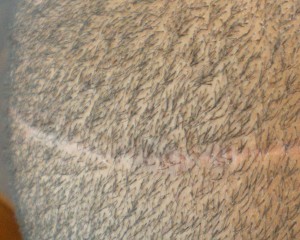Thursday, June 25th, 2009
For previous hair transplant patients, scar revision is the process of correcting or minimizing the scar appearance left after a hair transplant procedure. In the case of a patient email we received, his scar seems to be a bit wider on one side compared to the other. His transplant was performed in a different clinic and the result of the wide scar was of natural effect. He asks, “Is it better to do only half and not touch the good side so to speak?”
There are a couple of techniques that can be used to correct this issue. The most common is a simple excision and closure of the scar which may reduce the scar’s width. Considering the scar is behind the neck area, BOTOX can be applied to prevent future stretching. Some patients may require what is known as trichophytic closure which allows hair to grow into the scar further minimizing the appearance of the scar. Finally, the most effective way of eliminating scar visibility is by means of an FUE (follicular unit extraction) procedure to fill in the scar left behind by the strip procedure.
The maturation or completely healing of a scar is a timely occurrence. Scars can sometimes take as long as 6 months to fully develop and can continue to evolve even after that time but at a slower rate. Because of how long scars can take to fully develop, we avoid during any type of scar revision surgery until at least 6 months after wound closure. We offer free donor scar revision consultation at our Orange County hair restoration office.
Tags: Botox, donor scar revision, follicular unit extraction, fue, hair transplant donor scar, hair transplant scar revision, scar revision, stretched scar, strip procedure scar, trichophytic closure
Posted in after hair transplant, donor scar, hair transplant, Hair Transplant Procedure, men hair restoration, Orange County hair transplant | No Comments »
Monday, June 8th, 2009
 Hair restoration surgery through follicular unit transplantation is the golden standard for hair transplants to date. This procedure is designed to fully recreate a natural looking hairline and add density or restore lost hair caused by male or female pattern baldness. The only concerning factor of this technique is the scar that remains after the procedure is complete. Men especially whom have had hair restoration surgery have wondered and asked how short can their hair really be to avoid seeing or even noticing the scar and if there is a way to avoid such a scar?
Hair restoration surgery through follicular unit transplantation is the golden standard for hair transplants to date. This procedure is designed to fully recreate a natural looking hairline and add density or restore lost hair caused by male or female pattern baldness. The only concerning factor of this technique is the scar that remains after the procedure is complete. Men especially whom have had hair restoration surgery have wondered and asked how short can their hair really be to avoid seeing or even noticing the scar and if there is a way to avoid such a scar?
The linear scar that is left after a hair restoration procedure through strip technique is really inevitable but can be made less visible depending on your hair transplant surgeon. Most facilities that do hair transplant practice a technique known as trichophytic closure for their patients. Trichophytic closure is a technique used where hair follicles will penetrate through the donor scar which, in turn, minimizes its visibility and detect ability. This can be compromised if the scar ends up stretching or widening. Another study conducted has shown that BOTOX can be used to prevent further stretching or widening of the donor scar and must be applied by a professional physician for best results.
The length of a person’s hair is really up to the patient or their stylist’s best disclosure. Most donor scars are minimal and undetectable but in most cases anything shorter than a #2 clipper (1/4″ buzz cut) may make the scar visible.
The only other option available to minimize scarring is through a different hair transplant technique called follicular unit extraction (FUE). This technique is done by selectively extracting follicular units and refining them for hair transplantation. The result is undetectable and the downtime is even less than that of follicular unit transplantation through strip technique. This procedure can also be used to fill in existing scars where hair use to grow or the donor scar area. Findings on this type of procedure were originally published when conducted on patients with neurological scar revision.
Tags: after hair transplant, crew cut, donor scar, donor scar revision, donr complications, hair transplant donor scar, linear scar, shaving head, stretched donor scar, strip technique donor scar, trichophytic closure, visible donor scar, wide donor scar
Posted in donor scar, hair transplant | No Comments »

